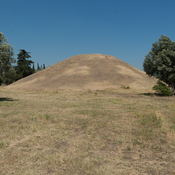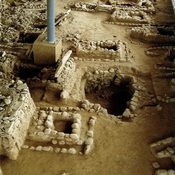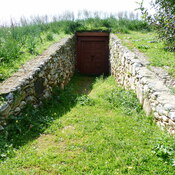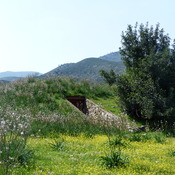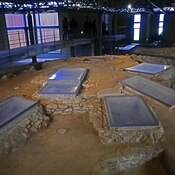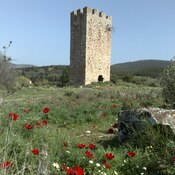Es gibt noch keine deutschsprachige Anmerkungen. Präsentiert wirden Anmerkungen auf English.
On the southern end of the Marathon plain, within a small marsh known to the locals as Brexiza, the archaeological hoe has unearthed a sanctuary dedicated to Egyptian gods. Although remains in the area were first noted in the 18th and 19th centuries, the excavations started in 1968 when the monuments were brought to light during the building of a hotel. It is believed to be the Ἱερὸν τοῦ Κανώβου (mentioned by Philostratus) founded around AD 160 by Herodes Atticus. The sanctuary has a square shape, 50m long, featuring courtyards, corridors, marble staircases and a truncated stepped pyramid at its center. Access is by four monumental entrances, oriented to the cardinal points. Every entrance is flanked by internal and external colossal statues, one male and one female. The male statues represent the god Osiris, possibly in the face of Antinoos, favoured of the Emperor Hadrianus. The female statues represent the goddess Isis as Isis–Demetra (holding corns) or Isis–Aphrodite (holding roses). There is also a staircase at the South side of the eastern gate; it may have given access to an observational platform or tower. To the East of the sanctuary a stoa has been found; it may have extended to the North, probably towards the harbor (still unidentified) that Herodes Atticus had also built in the area. To the SE of the sanctuary, a luxurious bath (βαλανεῖον) and a large pond have been excavated. In addition, two more structures can be traced on the South of the sanctuary; one in contact with the eastern part of the South wall, in parallel to the bath; one at the SW edge of the archaeological site.
- Dekoulakou I. 2011. «Le sanctuaire des dieux égyptiens à Marathōn», in L. Bricault & R. Veymiers (eds), Bibliotheca Isiaca II. Bordeaux: Éditions Ausonius, 23-46.
On the southern end of the Marathon plain, within a small marsh known to the locals as Brexiza, the archaeological hoe has unearthed a sanctuary dedicated to Egyptian gods. Although remains in the area were first noted in the 18th and 19th centuries, the excavations started in 1968 when the monuments were brought to light during the building of a hotel. It is believed to be the Ἱερὸν τοῦ Κανώβου (mentioned by Philostratus) founded around AD 160 by Herodes Atticus. The sanctuary has a square shape, 50m long, featuring courtyards, corridors, marble staircases and a truncated stepped pyramid at its center. Access is by four monumental entrances, oriented to the cardinal points. Every entrance is flanked by internal and external colossal statues, one male and one female. The male statues represent the god Osiris, possibly in the face of Antinoos, favoured of the Emperor Hadrianus. The female statues represent the goddess Isis as Isis–Demetra (holding corns) or Isis–Aphrodite (holding roses). There is also a staircase at the South side of the eastern gate; it may have given access to an observational platform or tower. To the East of the sanctuary a stoa has been found; it may have extended to the North, probably towards the harbor (still unidentified) that Herodes Atticus had also built in the area. To the SE of the sanctuary, a luxurious bath (βαλανεῖον) and a large pond have been excavated. In addition, two more structures can be traced on the South of the sanctuary; one in contact with the eastern part of the South wall, in parallel to the bath; one at the SW edge of the archaeological site.
- Dekoulakou I. 2011. «Le sanctuaire des dieux égyptiens à Marathōn», in L. Bricault & R. Veymiers (eds), Bibliotheca Isiaca II. Bordeaux: Éditions Ausonius, 23-46.






